R. & W. Hawthorn, Leslie & Co. Ltd.
Andrew Leslie, an Iron Shipbuilder
As a newly born baby, Andrew Leslie’s family along with hundreds of others, were evicted from their home in the Shetlands during the Highland Clearances in 1818. Growing up in Aberdeen he witnessed the busy docks and shipyards. At the age of thirteen he was apprenticed as a boilermaker where he progressed. When his employer died six years later he was entrusted with the management of the business, where he remained for about ten years.
J.H.S. Coutts (b. 1810), a draughtsman with Vernon, Bourne & Co., Aberdeen, trained Charles Mitchell (b.1820), who in turn taught Andrew Leslie technical drawing at night time!
When Coutts acquired a shipyard on the Tyne in 1842, he appointed Charles Mitchell Chief Draughtsman, who in due course would create his own famous shipyard in 1852.
At the age of 32 in 1850, Andrew Leslie was building ships at Granton on the Firth of Forth, but as the waters there were too shallow, he went prospecting for a river with better navigation to allow him to build larger ships.
Leslie’s friendship with Coutts, Mitchell, encouraged him to look for land on Tyneside. In 1853, Leslie applied to the Tyne Commissioners to create a shipyard at Hebburn, which at the time was farmland.
The word spread back to Aberdeen that there was work to be had on Tyneside, leading to a large community from the city moving, to the extent that Hebburn, on the southern banks of the Tyne, three miles downstream from Newcastle, would become known locally as ‘Little Aberdeen’.
Whilst having limited capital for the venture Leslie encouraged J.H.S. Coutts and others into partnership.
The first ship to be built was the 1,000 ton, three masted brigantine Clarendon for W.S. Lindsay, the M.P. for Tynemouth, and other businessmen of Newcastle. She was completed in January 1856 and was chartered for use by the British Government during the Crimean War.
In 1857 Charles Palmer had conveniently started his own iron mills just downstream at Jarrow, which made access to materials easier.
Most of Leslie’s early ships were brig rigged sailing vessels of about 130 feet and 200 grt, while an order for several barges for unidentified Russian owners were built in kit form for export
Leslie was an honourable man. Following the launch of one of his early contracts, he went to London to collect the appropriate payment, only to find that during the launching, the ship had unfortunately gone ashore on one of the sandbanks in the river. Always a soul of integrity he refused to accept payment, and sold his gold watch in order to pay for his fare back to the Tyne.
The company survived the vagaries of the cyclical shipbuilding market, and carried a lot of ship repair and lengthening work to compensate.
In Liverpool, when 20 years old George Holt went into partnership with William James Lamport (10 years his senior), to start up a shipping company in 1845. In the early years they built up a fleet of thirteen sailing ships trading to the Americas, South Africa and India. The Holt family would come to have a profound impact on British Merchant shipping for over a century. George was the second of five sons, of an influential cotton broker in the city.
His brothers, William joined the family firm and Robert became the first Lord Mayor of the city. Alfred while initially working for George and Lamport and Holt as their qualified engineer, later formed his own Ocean Steamship Company in 1865 with the fifth brother Phillip. There was yet another connection with the famous Booth Line of Liverpool, as Charles Booth was a cousin of William Lamport who Phillip Holt also joined as a partner. By 1855, Lamport and Holt also held a large shareholding in the James Moss Co. trading with small steamers in the Egyptian cotton trade. William Lamport was unconvinced about the practicalities of steam propulsion, but relented and the company took delivery of two brig rigged steamers for their Mediterranean service. The second of these was the Copernicus, completed in late 1861 by Andrew Leslie. This ship built for the Mediterranean routes was transferred to the South American trade before being sold to Messageries Imperiales of Marseilles later that year.
In 1862 Lamport and Holt became managers for their subsidiary the Liverpool, Brazil & River Plate Steamers, to go into completion with the Royal Mail Steam Packet Co. in the South American trade.
Alfred Holt was keenly involved with the design and construction of a new 1,372 grt ship that was ordered from Andrew Leslie’s yard. When the Kepler sailed on its maiden voyage on 18th July 1863, he sailed with it to assess the ships performance. He must have been pleased with the standard as this led over sixty ships being built for his brother’s and his own company.
Andrew Leslie established a strong client relationship for reliability, and between 1869-1885, there were only two years when they did not have on their building berths a ship for Lamport and Holt or Ocean Steamship Co.
The Lamport and Holt ships were used to take advantage of the American Civil War, and regularly carried cotton from the Southern States back to the mills at Manchester.
The Liverpool, Brazil & River Plate S.N. Co. Ltd. was formalised in 1865, and as the trade increased, more ships were ordered. A sister to the Kepler, the Galileo, was the first to be built for the company. Andrew Leslie kept the same basic design and layout for all the ships they built for the next 20 years, which were no more than modern day coaster size.
The brittle molecular nature of cast iron, under stress, which was used for ships’ propeller shafts was a constant threat. Of the 57 ships built for both companies, 13 suffered broken shafts, necessitating tows to ports with drydocking etc. The frequency of these breakdowns, led to ships carrying spares with them, to speed up replacements if needed.
Several ships of the fleet were lengthened and re-engined during the 1870s at Hebburn.
Andrew Leslie was a typical Victorian philanthropist, and thoughtful of the welfare of his employees. He had 400 houses built for his employees, a church, and a ‘Welfare Institute’ governed by the employees, which incorporated a large dance hall and school, he also made a large contribution towards the creation of an infirmary in the town.
When Andrew Leslie died in 1894, hundreds of his former colleagues and employees joined a huge cortege and walked the four miles to Newcastle Central Station, where the coffin was taken north to be buried in the family plot in Leith cemetery.
Of the 265 ships built by Andrew Leslie, 42 were for Lamport and Holt and 16 for Alfred Holt.
R. & W. Hawthorn, Leslie & Co. Ltd.
The brothers Robert and William Hawthorn had formed a partnership in 1820 to build steam and marine engines at Forth Banks at the eastern end of Newcastle. Robert had founded the steam engine works in 1817.
In 1885 Andrew Leslie amalgamated with the engine builders Robert & William Hawthorn Co. The company was founded in 1820, supplying colliery winding engines, and built up a close relationship with George Stephenson the locomotive engineer. In 1831 they constructed their first locomotive for the Stockton & Darlington Railway, and by 1874 they had built 1,065 locomotives. By 1850 the brothers saw future prospects for marine propulsion and decided to expand their marine business.
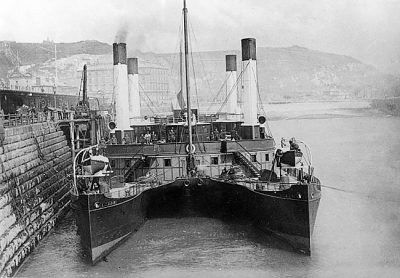
Arthur Coote who was Leslie’s partner and son-in-law, saw the strategic and financial prospects of a merger after Leslie had retired in 1884 with the amalgamation taking place two years later.
The two concerns merged in 1886
In the same year they purchased a large site at St. Peters Quay, further upstream towards Newcastle from Hebburn, which was used for the design and construction of marine engines and auxiliaries from 1882 to 1968. Being positioned near to the Armstrong Mitchell shipyard they supplied most of the ships built there with machinery.
The Forth Banks works was left to concentrate on locomotives, which operated until 1944 when the business was sold.
In 1885 the management of the two companies saw the logic of a unified approach of total ship construction, under the guidance of Arthur Coote and F.C. Marshall. & W. Hawthorn, Leslie & Co. was registered as a public company on 1st July 1886.
The early years were trying for the hard working Arthur Coote who did not have the flare of Andrew Leslie and the shipyard did not make a profit until 1894. The cyclical vagaries of the financial markets also affected ship orders with recurring slumps, only marine engineering, ship repair and other activities kept the company viable.
Arthur Coote was born in Hunting-donshire in 1841, and served an apprenticeship of five years with Denny of Dumbarton. In 1863 he joined Andrew Leslie in the business, as he had married Leslie’s adopted daughter. Within two years his father had invested £20,000 in the company giving Arthur Coote a third share in the business. On Andrew Leslie’s retirement from the firm, he brought about the amalgamation with Messrs. R. and W. Hawthorn, and became the managing director of the Hebburn Shipyard, a position he held until his death aged 65 when killed in 1906 in a railway accident. He was also Chairman of the Anglo-Australian Steam Navigation Co. He was also a Member of the Institution of Naval Architects, of the North-East Coast Institution of Engineers and Shipbuilders, and of the Shipwrights’ Association.
In the 1860s Andrew Leslie had built a dry dock at the yard (502 x 66 feet), and they received a lot of contracts for the lengthening of ships and other ship surgery jobs. In 1885 the Austrian cargo ship Marquis of Sciclandis was converted into an oil tanker by building and inserting transverse and longitudinal bulkheads making eight tanks giving it a 2,250 dwt, capacity, which was followed by similar contracts.
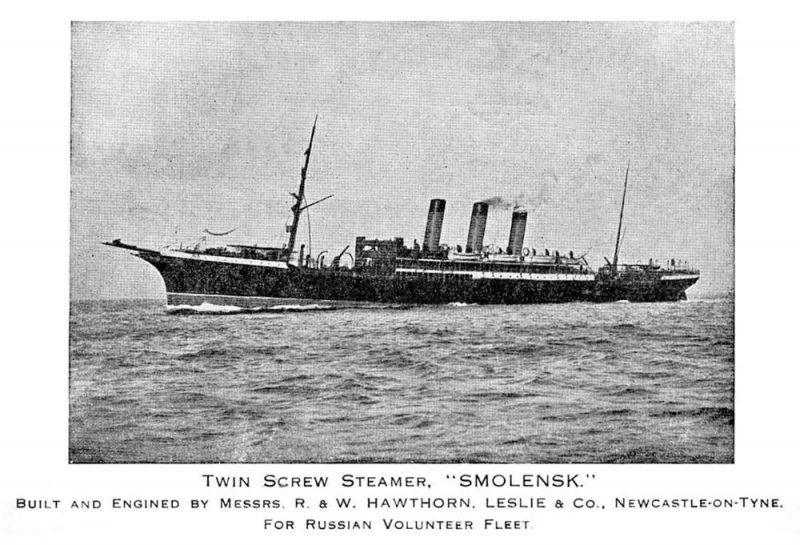
In the period 1868-1878 the yard produced 70 cargo ships, including 9 for Lamport & Holt, and 14 for Alfred Holt all in the 2,000 grt range.
One ship from the Andrew Leslie yard pre-amalgamation is worthy of mention, the 1,925grt Calais-Douvres of 1878, a revolutionary twin hulled catamaran style cross channel ferry. The 13 knot, Calais Douvres had paid for herself by 1883 but was then withdrawn in 1887 as she was too slow and she ended her days as a Thames coal hulk.
In the early years the new company had built a lot of small cargo and river craft for the Russian S.N. Co., which influenced the directors of the Russian Volunteer Fleet (RVF) when it was formed in 1878 at the behest of Czar Alexander III. Several UK shipbuilders were in St. Petersburg attempting to secure orders in tortuous and trying negotiating conditions, which the Hebburn builders secured with paper thin profit margins. As the RVF were in a hurry to acquire ships, initially they bought ships which were already under construction for other owners. Port Caroline, building at Hebburn, was bought whilst fitting out and renamed Kostroma. The builders became the largest supplier of ships to this fleet, with a total 11 ships built between 1888-1901. The last ship in the series was the splendid looking Smolensk of 20 knots and 7,270 grt. She had troop accommodation for 1,693 officers and men. This ship survived the war and was captured in the Black Sea by German forces in 1918. By the next year she was under the control of the Russian White Army, finally ending her days as a troop transport for the U.S.S.R., before being broken up in Italy in 1922.
The fleet made service runs between Nagasaki, Shanghai, Vladivostok and Odessa. Like the Russian East Asian Fleet, it spent the winter in the ice-free port of Nagasaki. When the Russo-Japanese War began in 1905, the ships were drafted in as troop transports from Odessa to Port Arthur. Two of the Hawthorn built ships, Orel and Ekaterinosla were captured, and put into service by the Japanese.
During this period the company began building refrigerated cargo ships and they built up a good reputation. It started when Turnbull, Martin & Co. ordered five 5,400 grt ships between 1889 and 1894. When in 1894 the Perthshire (5,574grt/1893) docked in London, it unloaded the largest refrigerated cargo to have been discharged, which included 70,000 carcasses of sheep, 9,000 haunches and 550 tons of frozen beef etc. Cayzer Irvine acquired these ships in 1910 and revamped its company name to Scottish Shire Line. In 1914 the Admiralty converted Perthshire into the dummy battleship H.M.S. Vanguard and this was followed by a period as a collier and stores ship at Scapa Flow. In 1920 she was converted to an oiler/ stores ship until broken up in 1934.
It was common practice amongst shipbuilders to accept old ships in part payment for new orders, which were subsequently repaired and re-fitted before being sold.
The company operated on a small clientele base of regular customers including Milburn, Leyland, Holt, Booth, J.D. Milburn of Newcastle etc.
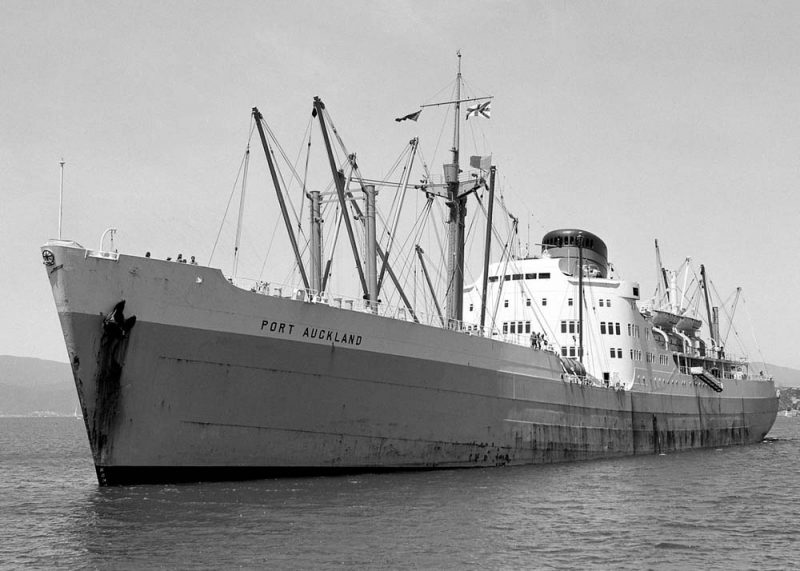
The 11,945grt Port Auckland was built in 1949. In 1976 she was converted into a livestock carrier and renamed Mashaalah, operating for Gulf Fisheries of Kuwait. On 30th September 1979 she arrived at Kaohsiung to be broken up by Chien Cheng Iron & Steel.
In 1879 Leslies built their first ship for J.D. Milburn, the Mangerton, which sank four years later when overloaded with coal for Havana. A strong owner/ builder relationship grew and as Milburn prospered so they returned to the yard for new ships. William Milburn and Arthur Coote were directors of the Anglo Australian S.N. Co. Ltd. (with Milburn as managers up to 1897), which introduced Milburn to the prospects of the Australian meat trade. They introduced Port Jackson into the trade in 1883 leading onto the development of the chilled meat trade. Milburn became one of the partners in the British & Commonwealth Line (later Port Line) in 1914, and via the early link the yard built 34 ships with the famous Port prefix over the next 70 years.
The penultimate construction for this company was the handsome Port Auckland (11,945grt/1949). With a distinctive superstructure, it’s 6 cylinder Hawthorn-Doxford engines gave her a service speed of 17 knots.
Dardanus (2,374grt/1886) was the last of the Blue Funnel ships to be built in the 19th century. She was sold to Japanese owners in 1894, and in May 1904 was used by the Government as a block ship at the entrance to Port Arthur during the Russo-Japanese war.
On 6th September 1899, the torpedo boat destroyer, H.M.S. Viper was launched, the first warship powered by steam turbines, built by Parsons Marine, and on trials achieved 36.858 knots on trials. Because of her high fuel consumption she was of little value to the fleet, and was used for patrolling in the western approaches to the English Channel. On 3rd August 1901 she was wrecked at Alderney, when cruising at 20+ knots in thick fog. 14 similar ships followed during the next 10 years.
In 1911 to service the various routes across the Bosphorus UK builders produced a series of ferries for the Turkish Maritime Administration. Hawthorns built 2 both of 413 grt, Bosphorus No. 67 & 68 for the Sirket-Hayriye route.
Warship output during World War I consisted of 2 light cruisers, 3 flotilla leaders and 20 torpedo boat destroyers.
In January 1915 Lloyd George expressed dissatisfaction with the output of warships and ammunition. There was a major problem with shortages of skilled manpower, as more men were called up to the front. Some of those left behind were transferred to Royal Dockyards to build warships. This left only minimal cover to build merchant ships.
Some skilled men were brought back from Flanders, to their former employment in the shipyards. At the same time there was a shortage of coal, due to the number of miners being sent to the front, to dig ‘fighting tunnels’ under battlefields.
Because of the manpower shortages, they were only called upon to build 1 type A and 4 type B standard (8,075dwt.) cargo ships. One type A was cancelled and the 4 B class completed after the war had ended.
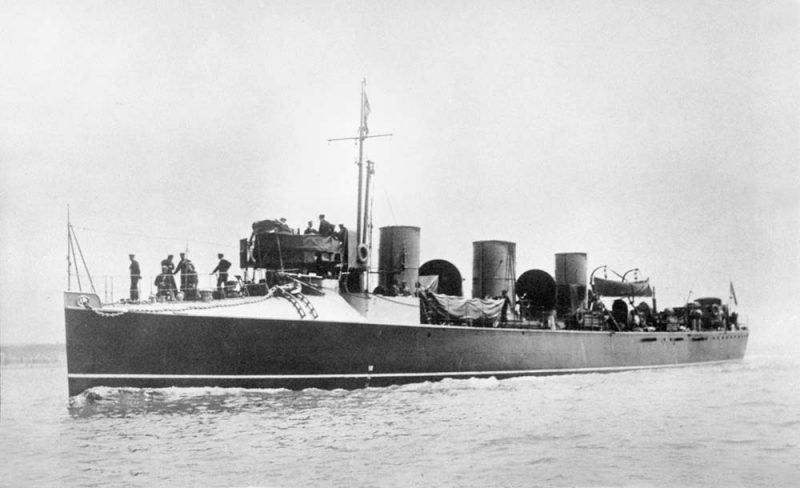
Antony (6,439grt/1907) was built for the Booth Line and was the first passenger steamer to be built for them, with capacity for 550 passengers on the UK-Amazon route. On 17th March 1917 she was torpedoed and sunk off Coninsbeg lightship, with the loss off 55 lives.
In November 1920 H.M.S. Verdun, a torpedo boat destroyer built at Hebburn in 1917, transported the body of the unknown warrior home to Dover, from Boulogne for its state funeral and interrment in Westminster Abbey.
The Andania, was one of a class of 3 intermediate liners built for Cunard for their London to Montreal service. Of 13,950 grt, she had accommodation for 500 first class and 1,200 emigrant class passengers. She started her maiden voyage on 1st June 1922.
On 14th December 1937 she disembarked her passengers from New York at Tilbury, and that evening proceeded in thick fog upstream to the Surrey Commercial Docks to unload her cargo. However when passing Purfleet, she veered off course and collided with, and badly damaged, the moored tanker British Statesman.
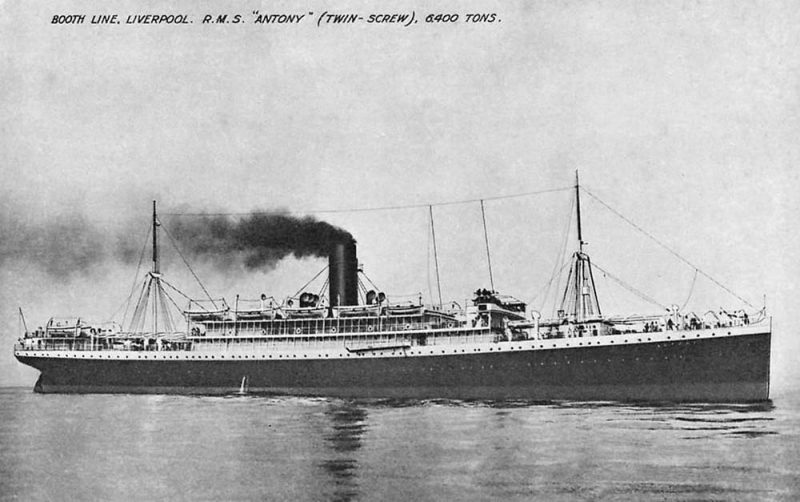

At the start of WWII she went to Cammell Laird for conversion into an auxiliary merchant cruiser. Trials were completed towards the end of November, then she sailed to join the North Atlantic patrol. However she was only to last until 16th June 1940 when she was torpedoed and sunk in the North Atlantic.
Ranpura was one of a quartet of ships built for P. & O. for the London to Bombay mail service. Ranpura was launched on 13th September 1924 and was 16,585grt, 9,00dwt with a service speed of 16.5 knots. She carried 312 first class and 268 second class passengers and was handed over to her owners on 8th April 1925.
When outward bound to India, she was in Aden as World War II loomed and was ordered to Calcutta where conversion to an auxiliary merchant cruiser took place. She was fitted with 8 six inch guns and commissioned as H.M.S. Ranpura on 27th November 1939. In the early part of 1940 she was on the Freetown convoy escort duties, followed by North Atlantic duties
In early 1942 she had a major refit at Bethlehem’s Baltimore yard, and was then transferred to the East Indies Station, patrolling between Aden, Mombasa, Durban and Bombay.
In December 1943 she arrived on the Clyde, and then went to Portsmouth to be converted into a heavy naval repair ship for the British Pacific Fleet. The conversion took two years and she did not re-commission until 22/04/1946. She sailed for Singapore but as the war had finished when she arrived at Malta, she was attached to the Mediterranean Fleets operations. She finally left the area in November 1958 to be laid up finally arriving in La Spezia for demolition in 1961.
Her sister Ranchi was also put onto the Bombay mail service from the UK. In August 1939 she too was commissioned as an auxiliary merchant cruiser on patrol with the British Eastern Fleet. In 1943 on her return to the UK she was converted into a troopship. In this role she was active in the Mediterranean, Middle East and India, and took part in the landing of troops during the invasion of Italy. In November 1944 she came close to being sunk in an air attack when north of Benghazi. De-requisitioned in 1947 and returned to P. & O. she was converted into an emigrant ship at Belfast, for 950 passengers on the assisted passage scheme to Australia. She was broken up in 1953.
British India S.N. were not regular customers of the yard but they ordered 5 passenger ships in 1923. Tamla was the first of a pair of 14 knot, 10,000grt ships for the Calcutta-Far East service, with accommodation for 134 passengers in cabins and 3,150 deck passengers. She cost £285,000 to build, and was completed in September 1923. Her war time career was uneventful, requisitioned as a personnel ship. After the war she transferred to the Calcutta-Australia route until broken up in 1949. Her sister Tilawa had a similar career but was on the Bombay to East Africa route as a personnel ship, but was sunk by the Japanese submarine I-29, as she made her way from Bombay to Mombasa, on 23rd November 1942, with 280 lost out of a total complement of 958 on board.
Talamba of 8,018grt, with 128 passengers in cabins and 2,777 deck passengers was completed in October 1924 for the Calcutta to Japan route. However in the 1930s she was switched to the Calcutta-Rangoon-Penang-Singapore service. She was anchored in Hong Kong in early September 1937, when it was hit by a typhoon. The storm forced her onto rocks with her stern high and dry, but the engine room and forward holds were flooded. Re-floated and dry-docked she was not repaired until March 1938. Initially she was used as a personnel ship when war broke, but by June 1941 she had been converted into Hospital Ship No. 43, with 485 beds and 110 staff. Despite showing her markings clearly on 10th July 1943, while embarking the wounded from the Sicilian landings she was attacked by a German bomber and sunk. Fortunately 400 of the wounded were picked up by other ships.
Rhona, like the other ships, was employed on the Indian routes to the Far-East, where she spent the opening years of World War II. In 1942 she was operating in the Mediterranean, and also involved with the Sicilian landings. In November 1943 when in a convoy bound from Oran to India with 2,000 American troops on board, she was hit by a radio controlled glider bomb when off Bougie and was lost, with a crew of 133 and over 1,000 troops.
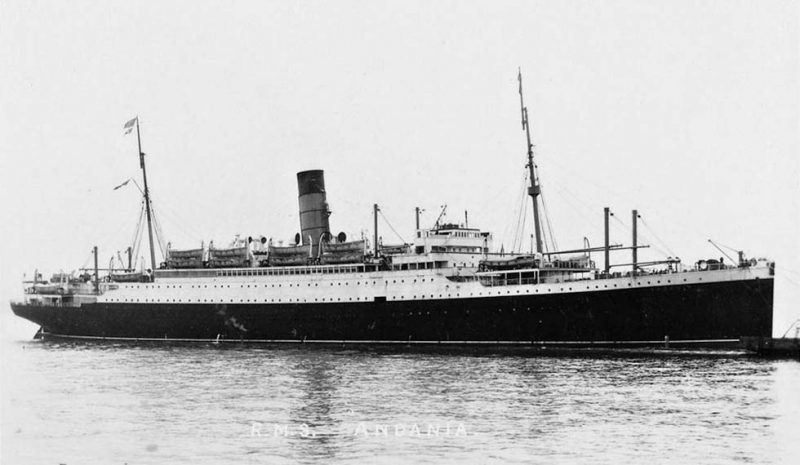
In 1928 the yard received its last order of 48 from Lamport and Holt stretching back to 1861. The Holt dynasty including Alfred Booth extended to a total of 86 ships built at the yard.
Anglo Saxon Petroleum Co. Ltd./Shell, were a regular customer from 1927. Bulysses of 7,159grt, was fitted with a Werkspoor engine. She was the first of 29 built for the fleet by the company.
Deucalion (7,740grt/1930) was the last of 31 to be built for Alfred Holt. On 12th August 1942 whilst on a voyage as a stores ship in a Malta convoy from Glasgow, for Operation Pedestal, she was crippled by aircraft bombs in a position 37.56°N. 08.40°E., and became a straggler. As such she was sunk with an air-launched torpedo during a second air attack in a position 5 miles west, 270 degrees from Cani Rocks Tunisia.
In 1931 Agnita of 3,561grt, was built, and was the first ship designed to carry concentrated sulphuric acid and butane in bulk. On 22nd March 1941 she was sunk by the German raider Kormoran, near Freetown when on passage in ballast to Caripito, Venezuela.
The Company built a series of sloops for the Portuguese Navy in the 1930s. One of these was the Alfonson de Albuquerque. In December 1961 she was in action when India seized their colony of Goa. In the ensuing battle with a superior force she was crippled and grounded. She was towed off and broken up in Bombay in the following year.
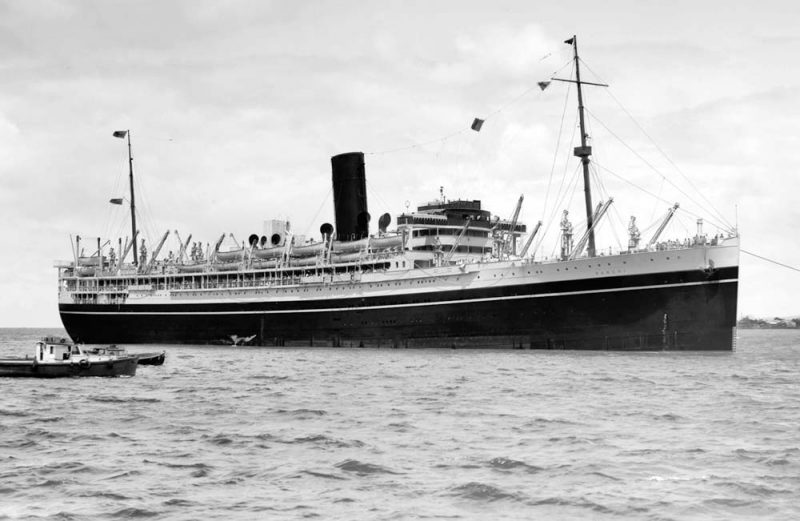
During the early 1930s the National Shipbuilders Security Ltd. announced that it was closing shipyards or decommissioning building berths on the River Tyne. There was mass unemployment as famous names the yards on the Tyne closed down. There had been 77 building berths on the river and almost 40 were dismantled. In 1933 there were only 2 ships on the stocks in the entire river. In Hebburn’s adjoining town of Jarrow, 7,000 were unemployed when Palmer’s closed. This was 75% of the working population. Poverty was so rife that men went down to the riverside looking for flotsam to take home to put on their fires! This desperate scene was mirrored all over the UK. Hawthorn Leslie was fortunate that they were able to retain 600 people. This forlorn state mirrored throughout the Europe, and did not improve until the drum beat increased towards war.
During World War II, 41 naval vessels were built including 3 cruisers, 2 fast minelayers and 11 destroyers, equating to 64,492 tons displacement. Also 17 merchant ships were constructed, 15 of which were tankers. The aircraft carrier H.M.S. Triumph was completed after the war ended. H.M.S. Kelly was built in 1939 in December 1940 she was torpedoed by a German MTB and almost sunk. However she was towed back to the Tyne and repaired. She was put back in service and while under the command of Lord Louis Mountbatten was attacked by German aircraft and sunk off Crete on 23rd May 1941, with the loss of 130 officers and men. Meanwhile the dry-docks department docked and repaired 121 naval vessels and 112 merchant ships.
Hawthorn’s became involved with Houlder Brothers and its subsidiaries for the refrigerated meat shipment trade. In 1915, when Houlder’s bought the Buteshire, (5,574grt/1893) from Elderslie S.S. Co. she initially took the name Bollington Grange, but when transferred to Furness-Houlder Argentine Lines in 1916, she was renamed Canonesa. A dramatic career followed during WWI having a close shave with a U-boat off Ushant, and being torpedoed off Worthing in May 1918. She was salved and continued in her trade until 1929 as Magicstar.
Other ships built for Houlders for the River Plate chilled meat trade all with a capacity of 12,000 tons included Beacon Grange built 1938 which was lost in April 1941 when torpedoed and sunk by U552 south of Iceland and Rippingham Grange (10,365grt/1943), Condesa (10,367grt/1944), Hornby Grange (10,785grt/1946) and Duquesa (11,007grt/1949).
An experimental propulsion system was built by the company and installed into the 12,290 dwt Anglo Saxon tanker Auris in 1947. The machinery pioneered diesel electric A.C. current propulsion, with one of her alternators was operated by a gas turbine, making her the first ocean going gas ship. Between October 1956 and July 1958 she lay alongside Cammell Lairds, having her four alternators removed and replaced by a gas turbine. She was laid up in the River Blackwater in June 1960 and eventually broken up at Blyth in August 1962.
In 1948 the company obtained a contract from Cia. Nacional de Navegacao, of Lisbon for the Angola, of 12,930 grt, with 734 passengers and troops, built to service their colonies in Africa.
Built in 1953, Haustrum was one of the numerous H class Shell tankers. She was hit by 5 shells from the Vietcong when in the Saigon river in June 1967 when in transit from Jakarta with lubricating oil.
The 31,465 dwt, Vola and Volatella were the largest ships built by the company for Shell in 1956. These were followed be a series of larger ships, which were subsequently chartered to the oil giant.
Two 7,500 dwt bauxite bulk carriers, Pathfinder and Prospector were built for the Pan Ore Steamship Company Inc. in 1949 to run on a shuttle trade between Surinam and smelters in Trinidad. Typically the two ships carried a combined total of 325,000 tons each year.
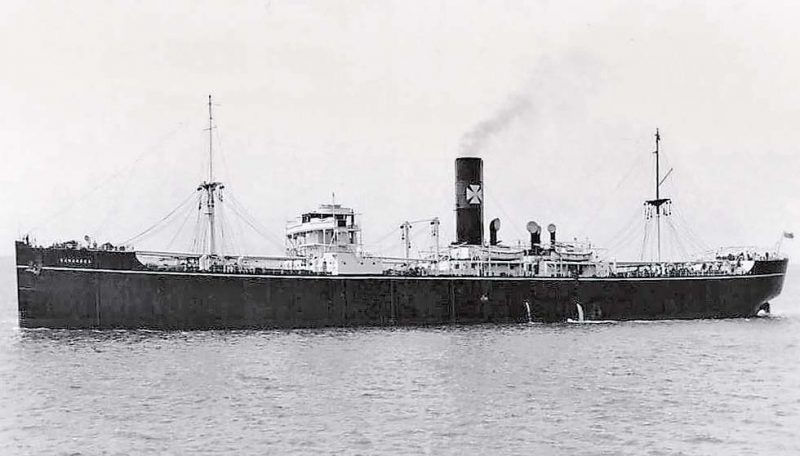
In common with many of the UK shipyards, there was a need to expand their facilities. This had become a pressing need with the increasing size of ships in the 1950s. Their layouts had been formed in the closing decades of the 19th century, and many of them found themselves hemmed in close to the river bank by industrial and urban sprawl.
Consequently the Hebburn yard was modernised and reorganised in 1958 to cater for larger ships and more modern production methods.
Two handsome refrigerated cargo liners, Hardwicke Grange (9,234grt/1960) and the ill-fated Royston Grange (9,035grt/1959) were built. These two ships were smaller but with a higher speed than the earlier Hornby Grange class in order to meet the requirements of the meat shippers.
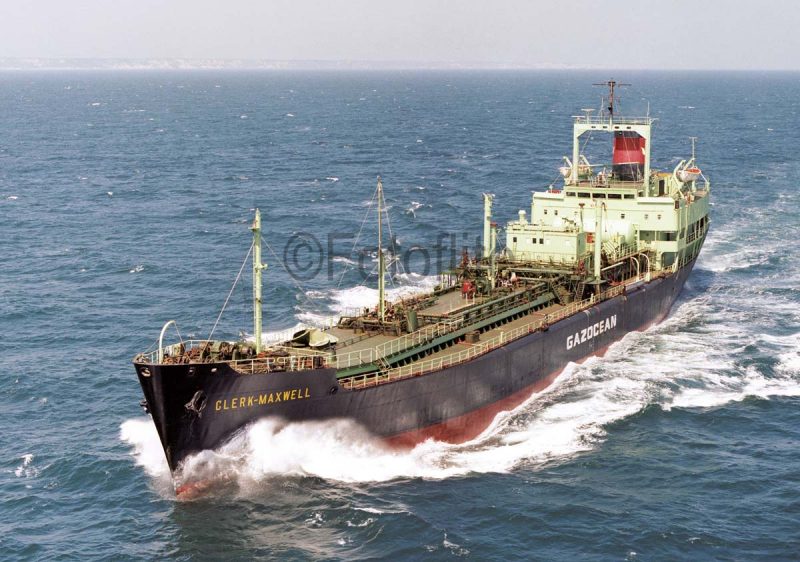
Royston Grange was in collision with the inbound and fully laden Liberian tanker Tien Chee (12,595grt/1955) in the River Plate when on passage from Buenos Aires to Montevideo on 11th May 1972. In the ensuing disaster the Royston Grange was gutted by fire with the loss of her entire crew of 61, plus 13 passengers and the Argentine pilot. The wreck was eventually broken up in Spain in 1974.
In 1961 the yard started building the first of 4 fleet replenishment oilers for the Royal Fleet Auxiliary, Tidepool, Tidespring, Olna and Olynthus. There were followed in 1966 by 3 large landing ships for use as the workhorses by the Army for transporting troops, stores and equipment world-wide. Taking their names from the knights of the round table, Sir Bedivere, Sir Tristram, and Sir Percival. Typical of their role, Sir Percival was in action carrying 300 troops and 3 helicopters leading to the amphibious assault at San Carlos during the Falklands war and was the first ship to enter Port Stanley at the war’s conclusion. She went on to be the last British vessel to leave Hong Kong when it was handed over to the Chinese. She also took part in both Gulf Wars, and carried out world-wide humanitarian activities.
The first BP tanker to have an all aft deckhouse arrangement was the 35,000dwt British Venture, which was launched on 8th December 1961. She was also fitted with the largest, at the time, bore Sulzer engine (8 cylinder 900mm bore), with an output of 16,000bhp.
As early as 1961 Hawthorn Leslie began to study the carriage of gas in a liquid state by sea, and by the next year had designed a 12,000 dwt, fully refrigerated L.P.G. Carrier. The design team gained approval from the U.S. Coastguard for the methods to be used, which they capitalised on.
The company had gained earlier experience in the building for these types of cargoes as in 1963 Hawthorn’s repair department had completed the conversion of the Stephenson Clarke coaster Broughty (553grt/1953) for the LPG (755m3) trade and renamed Abbas on completion. The Company had become one of the leading yards in the world capable of building complicated liquid gas carriers.
During the mid-1950s oil tankers were a staple diet for the yard, and in the next decade orders for them grew increasingly until the largest they could fit into the yard was the British Dragoon of 53,930 dwt in 1963.
In 1964 the company received its first contract to build an LPG tanker, the third to be built in the UK. Clerk-Maxwell (8,298grt, 9,055 dwt) was designed to carry propane, butane, butadiene and anhydrous ammonia under fully refrigerated conditions for Nile Steamship Co. Ltd., which chartered her to Ocean Gas Transport which was jointly owned by Houlder Brothers and Gazocean S.A. of Paris, formed in 1962 to build a fleet of gas carrying British flagged ships. In a loaded condition she could carry either 6,500 tons of propane or 7,600 tons of ammonia, and was delivered in the summer of 1967.
Meanwhile the ships engine works at St. Peters Quay at the eastern end of Newcastle continued to thrive. In March 1965 talks were started between Hawthorn Leslie, and George Clark/NEM with regard to a merger.
In the summer of 1968 there was talk of a possible merger between Doxfords and Hawthorn Leslie, in retrospect this turned out to be a co-operation agreement as Doxfords saw this as a progressive step towards the development of a new medium speed geared engine. They built steam turbines of the Pametrada design, and built Doxford, Sulzer, Werkspoor and Stork engines under licence.
In 1965 they delivered the first ro-ro car ferry to enter the Irish Sea route from Holyhead to Dun Laoghaire. The 3,878grt Holyhead Ferry I had a capacity for 150 cars and 1,000 passengers. She had been launched by the wife of the President of the Irish Republic Mrs. Sean Lemass. Her service was two round trips per day between Holyhead and Dun Laoghaire.
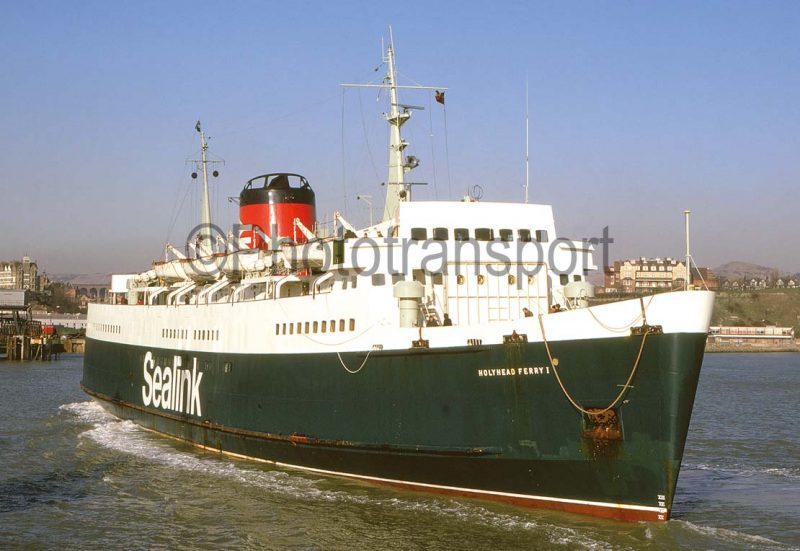
Other ferry orders for Sealink were to follow including the train ferry Cambridge Ferry (3,294grt/1963) carrying continental rail wagons and containers from Harwich to Zeebrugge on a daily run, followed by Antrim Princess (3,270grt/1967) on the Irish routes for the same owner.
On 14th November 1966 Hawthorns launched their first ocean going fully refrigerated liquid gas barge Petroquimco I (2,300 dwt) for Petroleas Mexicanos (Pemex). She was designed for the carriage of liquid ammonia, propane, butane and butadiene.
This was followed by the Mariano Escobedo delivered in late 1967 for the same owners which was designed to carry 9,400 dwt of cargoes such as propane, butane, anhydrous ammonia, and butadiene using direct refrigeration with a minimum temperature of –50F. It had been intended to name this ship Petroquimico III until a few days before her launch.
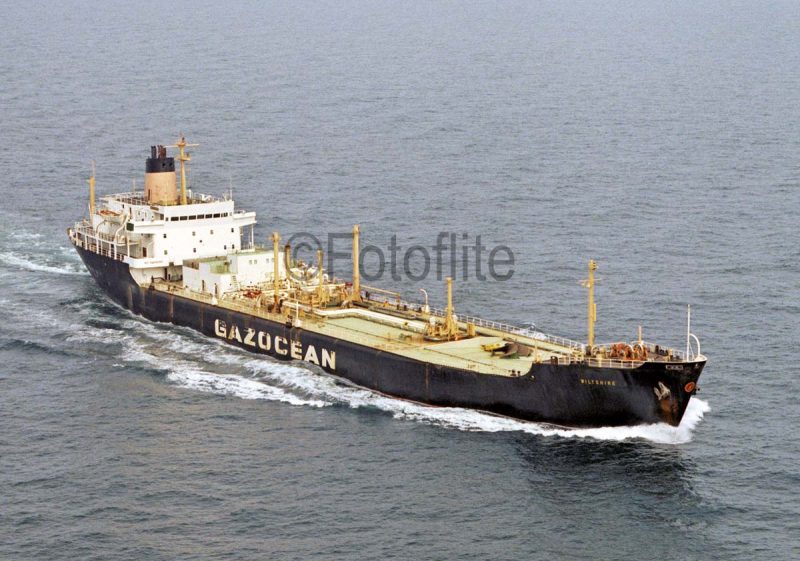
This was followed by the delivery in 1969 of the 3,340m3 gas carrier Emiliano Zapata for the same owners carrying propane, ammonia, and liquid ethylene at -104C.
In 1966 they received another order for a 12,300 dwt (15,502 m3) LPG tanker for Bibby Line, the Wiltshire, which was then chartered to George Gibson & Co. Leith, and delivered in 1968. She was a type of ship that the Company had built up an excellent reputation for, and was the last ship to bear the seahorse motif of the builders plaque on its bridge front.
This was to be the last ship prior to amalgamation with the other yards on the river.
Postscript
With government inspired shipbuilding rationalisation, under the Geddes plan, all five shipyards on the Tyne, and later two on the Tees came under the Swan Hunter Banner on 1st January 1968.
The Hebburn design office initially operated independently, within the new grouping and concentrating on the LNG/ LPG market.
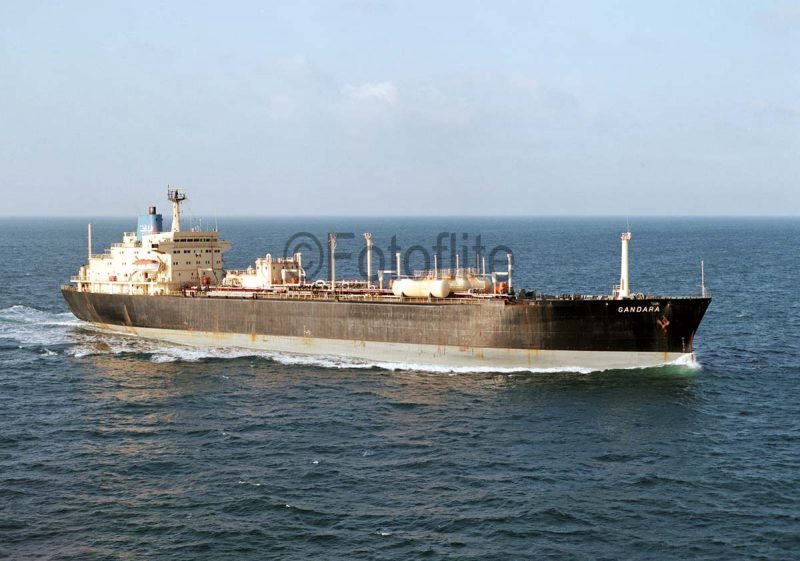
That year the yard was allocated an order for three 7,500 dwt fleet tankers of the Rover class, for the Royal Fleet Auxiliary. The first was Green Rover, launched in December 1968, then sold to the Indonesian Navy in 1992. Blue Rover was sold to the Portuguese Navy in 1993 for further service. Grey Rover was broken up in 2010 after forty years service with the Royal Navy.
A larger ship, the Faraday, was ordered to be built at the yard in August 1968. She was a 31,000m3 LNG tanker ordered for Ocean Gas Transport, and was launched in June 1970.
H.M.S. Cardiff which was launched in February 1974 by VSEL, Barrow was towed to Hebburn for completion in February 1976. The delivery date had slipped so badly and the Barrow yard did not have enough staff to finish the job. So the MOD (Navy) sub-contracted the work to Swans. The ship was commissioned in September 1979.
In August 1970 Ocean Gas Transport ordered an 88,000m3 (800 ft. long) LNG tanker from Swans with the option for two others. While the Hebburn design office handled the details, the ships would have been too large for the Hebburn yard to handle. It was programmed that they would have been built at Wallsend and outfitted at the former Vickers Armstrong, Naval Yard at Walker, which was also part of the Swan Hunter combine. However the orders were later cancelled by the owners because of a change in the trading options.
The last L.P.G. tanker to be built at the yard was the 22,711 m3 Gandara, built for P. & O. and completed in 1976.
From 1977 to 1989 the consortium of yards on the Tyne came under the Government’s British Shipbuilders which comprised of the 32 shipbuilders left in the UK, in yet another vain attempt to rationalise, by which time the writing was on the wall, and one by one the yards closed, until eventually the politicians and H.M. Treasury pulled the plug on a troubled and fractious period in UK shipbuilding.
Swan Hunter continued to use the yard which amongst others, built two ships for the Bank Line, and a series of 30,000 dwt product tankers, including three for Russia in the ill-fated Swan Maritime contract. The last ship to be built in the yard in 1982 was the irradiated nuclear fuel carrier Pacific Teal, for British Nuclear Fuels Ltd. The site was then utilised as a training centre for the trades required in the remaining shipyards on the river. In 1985 the local council announced plans to turn the yard into an historic Tyne shipbuilding exhibition centre, with H.M.S. Cavalier in the dry dock as the centrepiece.
Sadly the plans did not come off, and eventually H.M.S. Cavalier was towed away to be preserved at Chatham in 1998, leaving the site derelict, and a sad epitaph to a once thriving industry.


Comments
Sorry, comments are closed for this item